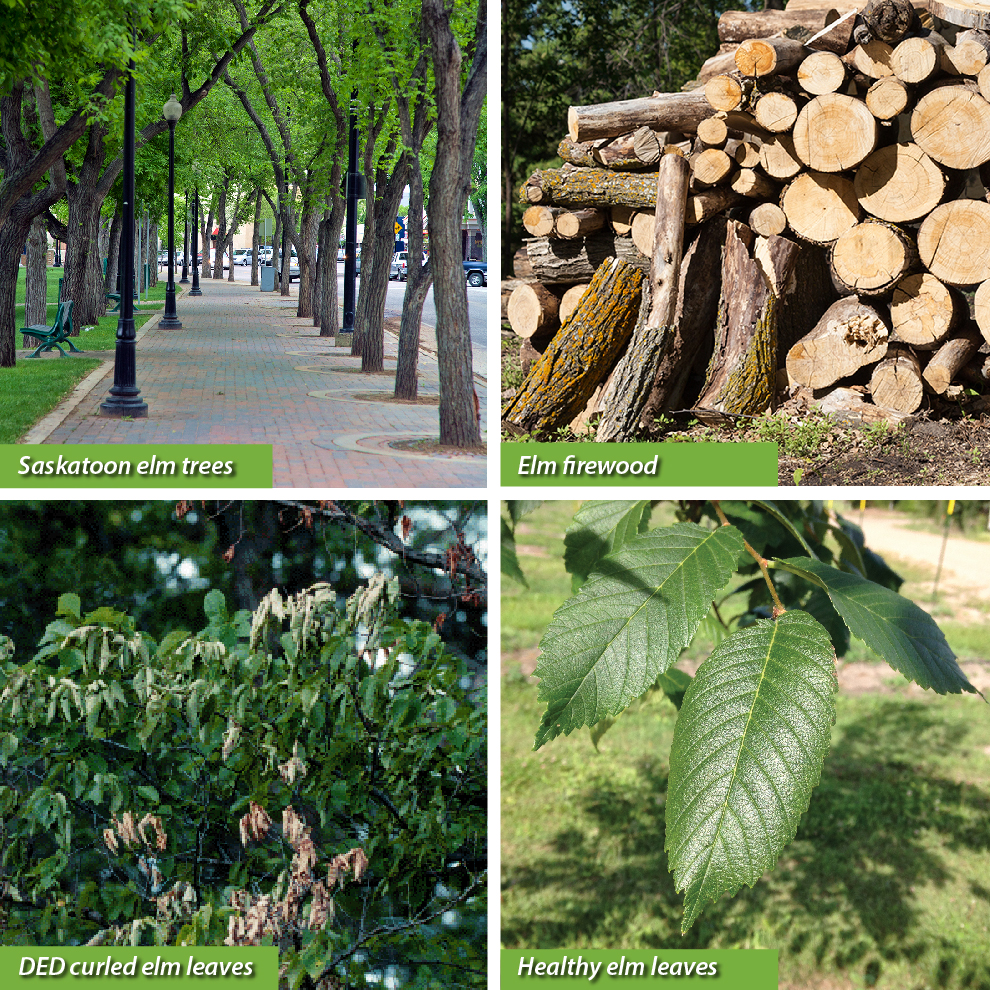Dutch Elm Disease
Record cases of Dutch elm disease confirmed in Saskatoon.
The City of Saskatoon Parks Department has confirmed a record number of positive cases of Dutch elm disease (DED). These cases are widespread and not concentrated in any particular neighbourhood.
The City has initiated its DED Response Plan, which includes:
• Immediate removal of the positive tree(s) and disposal at the City landfill
• Increased surveillance of the surrounding area to search for stored elm wood
• Sampling of symptomatic trees within one kilometre of the infected tree
• Continuing regular elm surveillance and cyclical pruning of trees in parks and on boulevards
Moving or storing elm wood spreads disease. DED is a serious disease caused by a fungus that clogs the elm tree’s water and nutrient conducting system, which eventually causes the tree to die. In Saskatoon, elms make up 25% of our urban forest. Help protect our elms by learning how you can help prevent DED.
You can help prevent DED by disposing of elm wood immediately at the Saskatoon Landfill. The disposal fee for all elm wood (commercial and residential loads) will be waived.
For more information please refer to the press release.
To help control the spread of DED the City has drafted a guide for arboricultural and landscaping service providers.

Elm trees, branches and firewood are attractive to an insect that spreads Dutch elm disease, a disease that kills elms and spreads rapidly.
In recent years, Saskatoon has confirmed several positive cases of Dutch elm disease (DED). As part of the City's aggressive DED Response Plan, infected trees are immediately removed and disposed of at the City Landfill. Surveillance and testing of symptomatic elm trees continues throughout the city.
What is DED?
DED is a serious disease caused by a fungus that clogs the elm tree’s water and nutrient conducting system, which eventually causes the tree to die. DED was introduced in North America in the 1930s and has since wiped out millions of elms across Canada and the United States.
How is DED spread?
In Saskatchewan, the disease is spread by several species of elm bark beetles. These beetles can fly farther than two kilometres in search of elm trees. The DED fungus has tiny spores that stick to the body of the beetle. Elm bark beetles can carry these spores and infect other elm trees. The fungus can also be spread through root grafts between trees and by infected pruning tools.
What does DED look like?
American elm trees with DED may start showing symptoms as early as June. Typically, the leaves will start to wilt and turn yellow, then curl and turn brown. Residents who start to notice any of these symptoms, are encouraged to complete the online form using the button below or call 306-975-2476.

How can DED be prevented?
Residents can help prevent the spread of DED by:
- Never storing elm wood or branches. Don't buy or take elm wood from anyone and don't burn it.
- Not pruning elms during the provincial pruning ban (April 1 to August 31).
- Disposing of elm at the City Landfill. Do not take elm to the compost depot or put it in your green bin. Dispose of it immediately, even if it is during the provincial ban.
- Sanitizing tools after working on elm trees
- Not building treehouses in elm trees, as the nail and screw holes can attract elm bark beetles
- Reporting dead or dying elm trees or branches to the City
The most effective management strategy for DED is to not transport or store elm wood. It is imperative that elm firewood not be used at any time. It is illegal and threatens the elms that make up 25% of our urban forest.
DED Response Plan
- Immediate removal of all positive trees
- Disposal of infected trees at the City landfill
- Sampling of adjacent trees
- Surveillance and testing of private and public trees in the surrounding area with an intensive search for elm material and other sources of infection.
The Forest Resource Management Act, the Provincial Dutch Elm Disease Regulations, 2005 allows inspectors to enter private property to inspect for elm wood, remove elm wood and sample private elm trees. In accordance with the regulations, property owners will be asked to remove and dispose of infected elm trees.
What does an elm tree look like?
From a distance, the American elm is one of the easiest trees to identify. The trunk is quite straight and often flares at the base. It forks into a few large, ascending limbs which divide repeatedly into fanning, drooping branchlets, forming a graceful umbrella shaped crown. For more information on identifying elm trees and elm wood, refer to the Elm Identification Handout.
Free disposal of elm wood for commercial and residential loads
Residents and contractors are now able to dispose of elm wood at the Landfill at no cost (for loads up to 1,000kg). This initiative aims to encourage the prompt and proper disposal of elm wood, reducing the risk of disease transmission to healthy elm trees. The City wants to remind people that an elm pruning ban is in place each year from April 1 until August 31; however, this new initiative means that any elm wood that has been completely removed, previously been cut, has fallen or was intended as firewood can be disposed of for free.
For more information on DED:
Canadian Food Inspection Agency - Dutch Elm Disease
Saskatchewan Ministry of Environment - Dutch Elm Disease
Need help with tree identification?
To request a tree inspection or identify elm wood, please complete the online form using the button below or call 306-975-2476.
